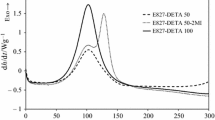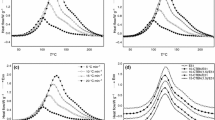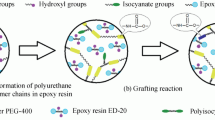Abstract
The kinetics of a poly(methyl methacrylate) (PMMA)-modified epoxy resin cured with different functionalities amine mixtures was analyzed using differential scanning calorimetry (DSC) in both isothermal and dynamic conditions. A delay in the reaction rate was observed which increased with PMMA content. An approach of kinetic features involved in curing was carried out. A linear dependence of preexponential factors of neat systems with modifier content was considered. The approach shows the contribution of other factors including the dilution effect of the functional groups to the observed delay. Fourier transform infrared spectroscopy (FTIR) indicated a noticeable change in the interactions present in neat systems due to the presence of PMMA. On the other hand, a significant influence of the ratio between each amine in the epoxy/amine mixtures on the final physical appearance was observed. At constant curing conditions, materials from completely opaque (phase separated) to transparent (miscible) were obtained with the increase in monoamine content.











Similar content being viewed by others
References
Williams RJJ, Rozenberg BA, Pascault JP. Reaction-induced phase separation in modified thermosetting polymers. Adv Polym Sci. 1997;128:95–156.
Siddhamalli SK. Toughening of epoxy/polycaprolactone composites via reaction induced phase separation. Polym Compos. 2000;21:846–55.
Naffakh M, Dumon M, Gerard JF. Study of a reactive epoxy-amine resin enabling in situ dissolution of thermoplastic films during resin transfer moulding for toughening composites. Compos Sci Tech. 2006;66:1376–84.
Bucknall CB, Gomez CM, Quintard I. Phase-separation from solutions of poly(ether sulfone) in epoxy-resins. Polymer. 1994;35:353–9.
Merfeld GD, Yeager GW, Chao HS, Singh N. Phase behavior and morphology of poly(phenylene ether)/epoxy blends. Polymer. 2003;44:4981–92.
Prolongo MG, Arribas C, Salom C, Masegosa RM. Mechanical properties and morphology of epoxy/poly(vinylacetate)/poly(4-vinylphenol) brominated system. J Therm Anal Calorim. 2007;87:33–9.
Girard-Reydet E, Sautereau H, Pascault JP, Keates P, Navard P, Thollet G, et al. Reaction-induced phase separation mechanisms in modified thermosets. Polymer. 1998;39:2269–79.
Yoon T, Kim BS, Lee DS. Structure development via reaction-induced phase separation in tetrafunctional epoxy/polysulfone blends. J Appl Polym Sci. 1997;66:2233–42.
Verchere D, Pascault JP, Sautereau H, Moschiar SM, Riccardi CC, Williams RJJ. Rubber-modified epoxies. II. Influence of the cure schedule and rubber concentration on the generated morphology. J Appl Polym Sci. 1991;42:701–16.
Remiro PM, Marieta C, Riccardi CC, Mondragon I. Influence of curing conditions on the morphologies of a PMMA-modified epoxy matrix. Polymer. 2001;42:9909–14.
Zhong Z, Zheng S, Huang J, Cheng X, Guo Q, Wei J. Phase behaviour and mechanical properties of epoxy resin containing phenolphthalein poly(ether ether ketone). Polymer. 1998;39:1075–80.
Guo Q, Huang J, Li B, Chen T, Zhang H, Feng Z. Blends of phenolphthalein poly(ether ether ketone) with phenoxy and epoxy resin. Polymer. 1991;32:58–65.
Wisanrakkit G, Gillham JK, Enns JB. Modeling reaction kinetics of an aminecured epoxy system at constant heating rates from isothermal kinetic data. Polym Mat Sci Eng. 1987;57:87–91.
Mijovic J, Fishbain A, Wijaya J. Mechanistic modeling of epoxy-amine kinetics. 1. Model compound study. Macromolecules. 1992;25:979–85.
Rozenberg BA. Kinetics, thermodynamics and mechanism of reactions of epoxy oligomers with amines. Adv Polym Sci. 1985;75:113–65.
Riccardi CC, Williams RJJ. A kinetic scheme for an amine-epoxy reaction with simultaneous etherification. J Appl Polym Sci. 1986;32:3445–56.
Xu L, Schlup JR. Etherification versus amine addition during epoxy resin/amine cure: an in situ study using near-infrared spectroscopy. J Appl Polym Sci. 1998;67:895–901.
Bonnet A, Pascault JP, Sautereau H, Taha M, Camberlin Y. Epoxy-diamine thermoset/thermoplastic blends. 1. Rates of reactions before and after phase separation. Macromolecules. 1999;32:8517–23.
Wise CW, Cook WD, Goodwin AA. Chemico-diffusion kinetics of model epoxyamine resins. Polymer. 1997;38:3251–61.
Swier S, Van Assche G, Van Mele B. Reaction kinetics modeling and thermal properties of epoxy-amines as measured by modulated-temperature DSC. II. Network-forming DGEBA + MDA. J Appl Polym Sci. 2004;91:2814–33.
Flammersheim HJ, Opfermann J. Formal kinetic evaluation of reactions with partial diffusion control. Thermochim Acta. 1999;337:141–8.
Blanco M, Corcuera MA, Riccardi CC, Mondragon I. Mechanistic kinetic model of an epoxy resin cured with a mixture of amines of different functionalities. Polymer. 2005;46:7989–8000.
Fox TG. Influence of diluent and of copolymer composition on the glass temperature of a polymer system. Bull Am Phys Soc. 1956;1:123.
Ritzenthaler S, Girard-Reydet E, Pascault JP. Influence of epoxy hardener on miscibility of blends of poly(methyl methacrylate) and epoxy networks. Polymer. 2000;41:6375–86.
Gomez CM, Bucknall CB. Blends of poly(methyl methacrylate) with epoxy resin and an aliphatic amine hardener. Polymer. 1993;34:2111–7.
Stefani PM, Riccardi CC, Remiro PM, Mondragon I. Morphology profiles generated by temperature gradient in PMMA modified epoxy system. Polym Eng Sci. 2001;41:2013–21.
Remiro PM, Riccardi CC, Corcuera MA, Mondragon I. Design of morphology in PMMA-modified epoxy resins by control of curing conditions. I. Phase behavior. J Appl Polym Sci. 1999;74:772–80.
Arribas C, Masegosa RM, Salom C, Arévalo E, Prolongo SG, Prolongo MG. Epoxy/poly(benzyl methacrylate) blends: miscibility, phase separation on curing and morphology. J Therm Anal Calorim. 2006;86:693–8.
Larrañaga M, Martin MD, Gabilondo N, Kortaberria G, Corcuera MA, Riccardi CC, et al. Cure kinetics of epoxy systems modified with block copolymers. Polym Int. 2004;53:1495–502.
Martinez I, Martin MD, Eceiza A, Oyanguren P, Mondragon I. Phase separation in polysulfone-modified epoxy mixtures. Relationships between curing conditions, morphology and ultimate behavior. Polymer. 2000;41:1027–35.
Girard-Reydet E, Riccardi CC, Sautereau H, Pascault JP. Epoxy-aromatic diamine kinetics. 2. Influence on epoxy-amine network formation. Macromolecules. 1995;28:7608–11.
Janarthanan V, Thyagarajan G. Miscibility studies in blends of poly(N-vinylpyrrolidone) and poly(methyl methacrylate) with epoxy resin: a comparison. Polymer. 1992;33:3593–7.
Larrañaga M, Martin MD, Gabilondo N, Kortaberria G, Eceiza A, Riccardi CC, et al. Toward microphase separation in epoxy systems containing PEO-PPO-PEO block copolymers by controlling cure conditions and molar ratios between blocks. Colloid Polym Sci. 2006;284:1403–10.
Riccardi CC, Adabbo HE, Williams RJJ. Curing reaction of epoxy resins with diamines. J Appl Polym Sci. 1984;29:2481–92.
Varley RJ, Hodgkin JH, Hawthorne DG, Simon GP, McCulloch D. Toughening of a trifunctional epoxy system Part III. Kinetic and morphological study of the thermoplastic modified cure process. Polymer. 2000;41:3425–36.
Woo EM, Wu MN. Blends of a diglycidyl ether epoxy with bisphenol-A polycarbonate or poly(methyl methacrylate): cases of miscibility with or without specific interactions. Polymer. 1996;37:2485–92.
Mondragon I, Remiro PM, Martin MD, Valea A, Franco M, Bellenguer V. Viscoelastic behavior of epoxy resins modified with poly(methyl methacrylate). Polym Int. 1998;47:152–8.
Blanco M, López M, Álvarez de Arcaya P, Ramos JA, Kortaberria G, Riccardi CC, et al. Thermoplastic-modified epoxy resins cured with different functionalities amine mixtures. Morphology, thermal behaviour and mechanical properties. J Appl Polym Sci. (in press).
Fedors RF. Crosslinked block copolymers. J Polym Sci Part C Polym Symp. 1969;26:189–99.
Bellenger V, Morel E, Verdu J. Solubility parameters of amine-crosslinked aromatic epoxies. J Appl Polym Sci. 1989;37:2563–76.
Rastegar S, Mohammadi N, Bagheri R. Development of co-continuous morphology in epoxy poly(methyl methacrylate) (PMMA) blends cured by mixtures of phase-separating and non-phase-separating curing agents. Colloid Polym Sci. 2004;283:145–53.
Kwei TK. The effect of hydrogen bonding on the glass transition temperatures of polymer mixtures. J Polym Sci Polym Lett Ed. 1984;22:307–13.
Uner B, Ramasubramanian MK, Zauscher S, Kadla JF. Adhesion interactions between poly(vinyl alcohol) and iron-oxide surfaces: the effect of acetylation. J Appl Polym Sci. 2006;99:3528–34.
Huang CF, Kuo SW, Lin HC, Chen JK, Chen YK, Xu H, et al. Thermal properties, miscibility and specific interactions in comparison of linear and star poly(methyl methacrylate) blend with phenolic. Polymer. 2004;45:5913–21.
Ni Y, Zheng S. Influence of intramolecular specific interactions on phase behavior of epoxy resin and poly(ε-caprolactone) blends cured with aromatic amines. Polymer. 2005;46:5828–39.
Swier S, Van Assche G, Vuchelen W, Van Mele B. Role of complex formation in the polymerization kinetics of modified epoxy-amine systems. Macromolecules. 2005;38:2281–8.
Swier S, Van Mele B. Mechanistic modeling of the reaction kinetics of phenyl glycidyl ether (PGE) + aniline using heat flow and heat capacity profiles from modulated temperature DSC. Thermochim Acta. 2004;411:149–69.
Riccardi CC, Fraga F, Dupuy J, Williams RJJ. Cure kinetics of diglycidylether of bisphenol A-ethylenediamine revisited using a mechanistic model. J Appl Polym Sci. 2001;82:2319–25.
Urbaczewski E, Pascault JP, Sautereau H, Riccardi CC, Moschiar SS, Williams RJJ. Influence of the addition of an aliphatic epoxide as reactive diluent on the cure kinetics of epoxy/amine formulations. Makromol Chem. 1990;191:943–53.
Flammersheim HJ. Typical sources of error in the kinetic analysis of models with pre-equilibria: DSC investigations of epoxide-amine curing reactions. Thermochim Acta. 1997;296:155–9.
Zucchi IA, Galante MJ, Borrajo J, Williams RJJ. Thermodynamic analysis of the reaction-induced phase separation in model systems based on blends of a rubber in diepoxide/monoamine precursors. Macromol Symp. 2003;198:295–307.
Girard-Reydet E, Riccardi CC, Sautereau H, Pascault JP. Epoxy-aromatic diamine kinetics. Part 1. Modeling and influence of the diamine structure. Macromolecules. 1995;28:7599–607.
Acknowledgement
M. Blanco wishes to thank University of the Basque Country (UPV/EHU) for her Ph. D. grant. C. C. Riccardi thanks Gobierno Vasco/Eusko Jaularitza for its financial support. The authors also wish to express their gratitude to Ministerio de Educación y Ciencia/Feder (MAT2006-06331 project) and Eusko Jaularitza/Gobierno Vasco (IT-365-07 Grupos Consolidados).
Author information
Authors and Affiliations
Corresponding author
Rights and permissions
About this article
Cite this article
Blanco, M., López, M., Fernández, R. et al. Thermoplastic-modified epoxy resins cured with different functionalities amine mixtures. Kinetics and miscibility study. J Therm Anal Calorim 97, 969–978 (2009). https://doi.org/10.1007/s10973-009-0174-5
Received:
Accepted:
Published:
Issue Date:
DOI: https://doi.org/10.1007/s10973-009-0174-5




